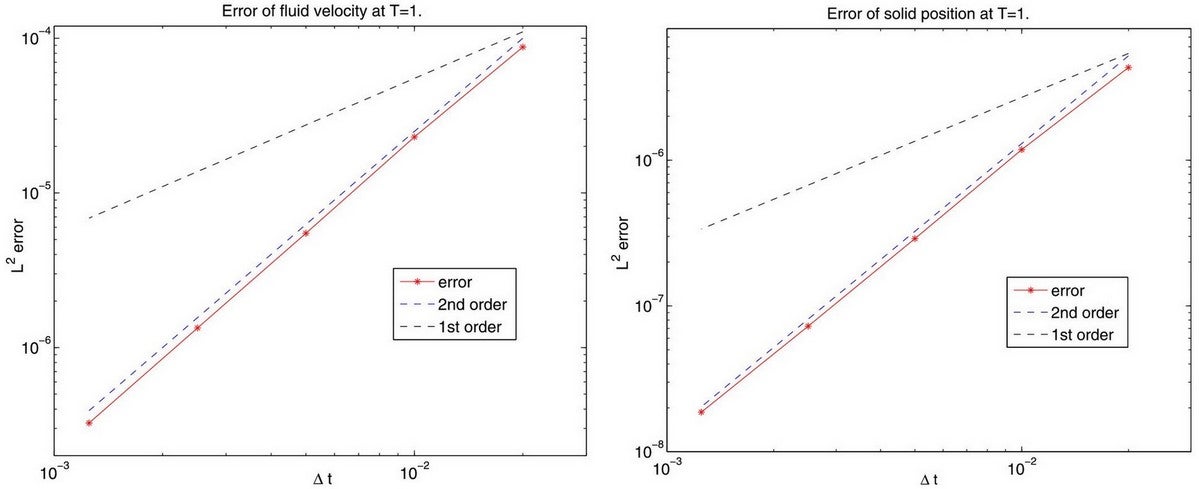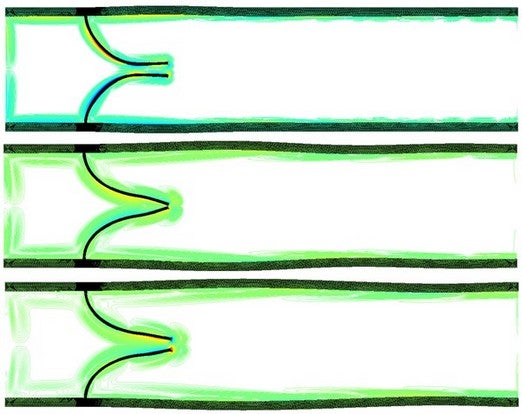Fluid structure interaction
LIU Jie ((Group Leader, Mathematics) ) November 14, 201614 Nov 2016. NUS mathematicians have developed an efficient and stable numerical method to solve fluid structure interaction problems involving large convections of fluid and near-contact of structures.
Computational fluid dynamics (CFD) uses numerical analysis and algorithms to solve and analyse problems involving fluid flows. One of the main challenges in computational fluid dynamics is to simulate a fluid flow with strong convection effects in an efficient yet accurate manner. The “Characteristic Galerkin” method is considered to be one of the best methods for such cases. However, this method has certain drawbacks. It is well known that it is not easy to find a second order variant of it and its convergence properties are ruined by quadrature errors.
Fluid structure interaction (FSI) studies the coupled system between a deformable structure with an internal or surrounding fluid. As the structures are deformable, contact of structures may happen in an FSI simulation. Unfortunately, this kind of contact can make the process very singular (for example, the viscous force can be very large or even infinite, [1]). An effective simulation algorithm needs to be shown to be reliable but existing algorithms are too complicated to be analysable, at least from a mathematical point of view.
Prof LIU Jie from the Department of Mathematics, NUS has developed a “changing-connectivity Arbitrary Largangian-Eulerian (ALE)” method that can overcome these challenges. It is a generalisation of the traditional “Characteristic Galerkin” method. This new method has been proven to have optimal convergence rates in both space and time for CFD problems and to be stable for FSI problems with near-contact of structures. The efficiency of the scheme is mainly due to the explicit interface advancing feature. With this feature, the computational complexity of the nonlinear FSI system is transformed into a much simpler linear system of equations for each time step.
Moving on, Prof Liu intends to study contact mechanics and its interactions with FSI. Once again, the aim is to reduce the complexity of the problem by proper decoupling and linearization which can greatly improve the computational efficiency and reliability of the scheme. These research outcomes would find potential applications in designing wind power generators and offshore platforms in Marine and Offshore Engineering.

Figure above shows the second order temporal accuracy for both fluid and structure variables. The red dots (connected by straight lines) are errors with different time step size .

Figure above shows the fluid vorticity (measure of the local rotation of the fluid) contour plot and structure position at different instants: t=0.1 (upper plot), t=0.275 (middle plot), and t=0.4 (lower plot). As the fluid enters the elastic tube from the left, the two elastic flaps inside the tube first close and then open up again. This simulates the flow induced motion of the heart valve. The changing-connectivity ALE method allows one to handle the large compression and stretching of the fluid mesh that lies between the flaps during the process.
References
[1] Liu J*, “Collision and no collision of spheres moving in axisymmetric Stokes flow in 3D”. Manuscript submitted in 2016.
[2] Liu J*, “A second-order changing-connectivity ALE scheme and its application to FSI with large convection of fluids and near contact of structures” JOURNAL OF COMPUTATIONAL PHYSICS Volume: 304 Pages: 380-423 DOI: 10.1016/j.jcp.2015.10.015 Published: 2016


